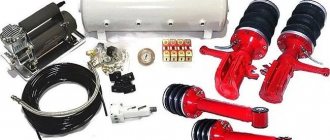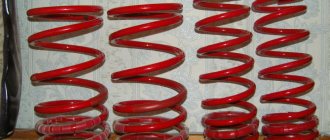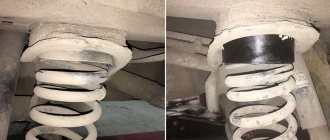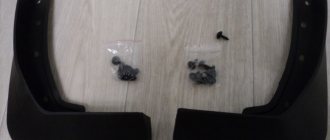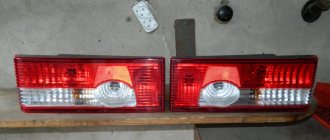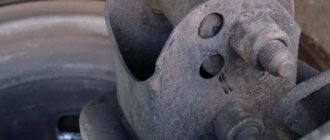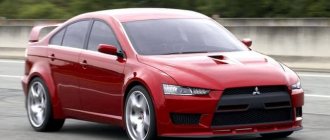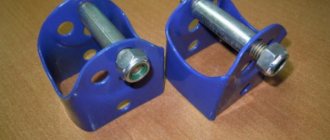There are many directions in car tuning, one of them has always been to change the ground clearance, that is, ground clearance, towards an increase. More precisely, the height of the body above the road, since not all authors of such innovations think about the concept of off-road geometry in general and ground clearance in particular. But in practice there is no big difference; the car really “grows” noticeably.
Why is there a need to increase vehicle ground clearance?
The amount of ground clearance is related to the vehicle's cross-country ability. This is obvious, but does not always manifest itself in practice. But other components of this tuning really work:
- the likelihood of damage to parts located under the bottom of the car due to road irregularities is reduced;
- You can safely pass large pieces of road debris between the wheels;
- the car looks noticeably more cheerful, it seems to be shedding the weight of several years of operation, which caused fatigue in the suspension springs;
- Additional space is freed up in the wheel arches, which allows the use of larger tires.
In addition, the procedure for increasing ground clearance is attractive due to its relative simplicity. It is enough to purchase spacers for springs or shock absorbers.
Strictly speaking, installing them in a civilian sedan or hatchback is not exactly what is called a suspension or body lift for SUVs, but the effect is noticeable, and the goal was not to participate in a trophy raid.
How much will the car lift from the spacers?
Once you have decided to install such parts on your vehicle, you will naturally have a question - how much will the ground clearance of your car increase? It all depends on the following factors:
- thickness of spacers for supports, springs, struts or shock absorbers;
- vehicle weight - the smaller it is, the greater the lift height will be;
- the condition of the springs or struts - the newer they are, the higher the ground clearance will be;
- type of suspension.
As for the last characteristic, the following fact should be noted here: with a bridge suspension design, the ground clearance will increase strictly by the thickness of the spacer, while with a multi-link design, the ride height will increase by a slightly greater value than the thickness of the installed product.
What are spacers and how do they work?
MacPherson type suspensions are now extremely widespread. In addition, it is in this case that the lift is really most simple.
A typical MacPherson spark plug suspension consists of:
- a shock absorber, which here is made in the form of a telescopic strut with a developed body that acts as a guide vane, damper and base for mounting additional elements;
- a spring, which is part of the same strut along with its support pads, but acts in a completely independent role as an elastic element;
- upper and lower supports of the rack, allowing it to swing and rotate relative to the body;
- additional levers and suspension braces with their own silent blocks or ball joints.
The height of the car body above the road is determined by the length of the telescopic strut under a given load, which caused compression of the spring by a certain amount. If you change this length, the ground clearance will change, although the length of the compressed spring will remain the same.
The easiest way is to use spacers between the shock strut upper mount housing and the body.
The geometry here is such that for every millimeter of spacer thickness, the body height will be increased by a millimeter with a small addition. This becomes clear if we consider the suspension using the lever rule. But there are also those where the change in ground clearance will be exactly equal to the thickness of the spacer.
Usually, when purchasing a kit, it is indicated how much the car will be raised, for example: “A set of front strut spacers plus 30 mm.”
Disadvantages of using spacers
Despite their effectiveness, installing spacers on the front springs has several significant disadvantages:
- the reliability and rigidity of the suspension is impaired, the width of the wheelbase, wheel alignment and wheel steering angle changes;
- the center of gravity of the car shifts, which reduces road stability and controllability;
- the position of the shock absorbers changes, which has a detrimental effect on their operation;
- The steering mechanism wears out much faster than before the modification.
The use of spacers on the rear wheels does not have significant side effects.
In order to reduce the negative effect, you need to follow the following rules:
- if aluminum spacers are used, they must be coated with anti-corrosion;
- For cars with front-wheel drive, you should not raise the front end by more than 20 mm;
- if the shock absorber is located at a distance from the spring, it makes sense to install spacers both under the springs and at the junction of the shock absorber with the car body. This is necessary to ensure synchronization of work;
- It is not recommended to raise the rear of the car by more than 30 mm.
Note that taking into account all the listed disadvantages, a more reasonable solution would be to install pneumatic cylinders.
Types of auto spacers
Each spacer is developed and created for a very specific car model, since all suspensions are structurally different.
They differ in the material used:
- hard plastics like nylon or ABS;
- relatively soft polyurethane;
- rubber;
- metal, usually aluminum and light alloys.
There is no particular difference in the use of different substances; we can only talk about a slight change in the comfort of the suspension depending on the softness of the spacers, but at the same time, the softer ones have less strength and service life.
Sometimes spacers of a different type are used, for example, in the form of enlarged spring pads or interturn pads. Such spring tuning should be avoided, since it is too rough an intervention in the combination of elastic and damping suspension elements.
Each of them has its own rigidity and its own range of stroke. Lengthening the spring or increasing its stiffness leads to overload of the shock absorber and hard shocks at the end of its working stroke. The resource decreases, the probability of breakdown increases. Both springs and shock absorbers break.
Main types of structures and materials
Front spacers are most often made, since the nose of the car and its bottom are most susceptible to contact with uneven road surfaces. Structurally, it is a bracket in which there are holes for fasteners. As for the rear spacers, they are made in the form of rings with several ears. Designs may vary depending on the make of the car. The material used is metal, polyurethane, rubber.
Rubber products do not have the same safety margin as their metal counterparts. But they are inexpensive, do not corrode and are resistant to aggressive environments. However, due to significant loads, they quickly wear out, collapse and deform.
Spacers based on polyurethane have almost the same properties. They retained the inherent elasticity and noiselessness of rubber, and also acquired their own advantages. First of all, this is increased strength, allowing them to safely take a blow of great force. Among the disadvantages, we note a higher selling price, as well as an increased load on the bushings.
The most durable of what the market offers are aluminum structures. In addition, they are characterized by all the same advantages as the analogues described above. They have a long service life and are not subject to corrosion. True, aluminum products are significantly more expensive.
Advantages and disadvantages
Even the simplest logical method of lifting by installing spacers in the upper supports of the struts does not promise anything good for the car, except for a slight increase in ground clearance, and then only in static conditions.
In dynamic mode, the independent suspension does not have the same level of stability as solid axles on SUVs. The body will sway, greatly changing the ground clearance.
The advantages of such a suspension include:
- a change in the static clearance by 2-3 centimeters, more is very undesirable;
- ease of installation, accessibility to anyone without special equipment;
- low costs, parts are sold as installation kits at a fairly low price;
- If desired, changes can be quickly removed.
But there are also potential problems to consider:
- the carefully calculated and selected suspension geometry changes, which is unsafe; the car’s handling will change, and certainly for the worse;
- the center of gravity of the body will increase, which will further add negativity to the stability of the car;
- the operating angles of the suspension elements, and especially the drives, will change, which will reduce their service life;
- it will become more difficult to adjust the wheel alignment angles, in some cases it is completely impossible without making additional changes to the suspension;
- The standard angles that any company sets at the stand will no longer be optimal; you will either have to make changes yourself or look for adjusters who are familiar with tuning suspensions.
It is worth considering whether it is necessary to use spacers or whether it will be enough to simply install new springs to replace the sagging ones; you can also choose a more rigid set as part of the standard configuration.
Conclusion
For passenger cars with low ground clearance, installing spacers to increase ground clearance is a beneficial solution. The main thing is to choose correctly, install correctly and operate correctly.
It is beneficial to install aluminum, rubber, silicone spacers. They just have different lifespans and affect driving differently. Aluminum ones are more durable, rubber and silicone ones are universally soft and do not affect control, but wear out faster.
In order not to significantly change the driving characteristics of the car, you should not raise the car more than 3 cm.
Instructions for installing front spacers to increase ground clearance
A detailed procedure for installing spacers is contained in the instructions included with the kit, since it greatly depends on the specific vehicle.
The design of the upper strut mounts can vary greatly, as can the features of the spacers. But there are also general points:
- many spacers do not require not only removing the spring from the strut, but also dismantling the strut altogether;
- in this case, unscrew the nuts of the studs securing the upper swivel support to the body glass with the car standing on its wheels;
- after lifting the car with a jack and installing it on a stand, the wheel is removed and a spacer is mounted on the upper part of the support;
- the studs are inserted into the standard holes of the glass and secured with nuts;
- the wheel is put in place and the car is removed from the jack;
- If difficulties arise, it may be necessary to either release the strut from the lower ball joint, outer CV joint, tie rod end, ABS sensor cable, brake caliper, or pre-compress the spring using a set of zip ties.
When unscrewing the shock absorber rod nut, you must be careful, making sure that the spring is compressed and there is no load on the nut.
What are there
p, blockquote 13,0,0,0,0 –>
Spacers for increasing ground clearance differ in the material from which they are made.
p, blockquote 14,0,0,0,0 –>
Metal
They have sufficient strength and do not lose their mechanical properties over time. Such spacers can be made of aluminum, copper and its alloys, and less often of steel. A disadvantage of such structures is the possible increase in corrosion due to electrolysis processes at the interface of two metal elements: the body and the spacer.
p, blockquote 15,0,0,0,0 –>
p, blockquote 16,0,0,0,0 –>
Rubber
Due to their elasticity, spacers help increase the smoothness of suspension movement and reduce noise effects. The disadvantage of the rubber structure is a limited resource, increased wear, especially under conditions of large temperature changes.
p, blockquote 17,0,0,0,0 –>
p, blockquote 18,0,0,0,0 –>
Polyurethane
Such spacers have a high degree of compression and are easily deformed, which, under conditions of high mechanical loads, negatively affects the rigidity of the structure and can lead to deformation of the suspension.
p, blockquote 19,0,0,0,0 –>
p, blockquote 20,0,0,0,0 –>
Plastic and composite
High-quality spacers made from such materials adapt to the car’s suspension design as much as possible and have minimal negative impact on the car’s components.
p, blockquote 21,0,0,0,0 –>
Typically, metal structures are used for the front suspension. Rubber, polyurethane and composite spacers are more suitable for rear suspension.
p, blockquote 22,0,0,0,0 –>
Structurally, spacers are made in the following form:
Installing spacers on rear struts for springs
Putting rear spacers under the springs is a dubious task. It is much easier to install adapters in the form of a steel bracket under the lower mount of the rack (house).
But if you really need to tighten the spring, you will have to remove and disassemble the entire rack:
- while the spring is compressed under the weight of the machine, screw ties are installed on its coils, and the rod is weakened as much as possible;
- the upper and lower fastenings of the rack are disconnected, after which it is removed from under the body;
- the rod nut is unscrewed, the upper support with the cushion is removed;
- a spacer is installed under the pillow;
- assembly operations are performed in reverse order;
- Most often, problems arise with corrosion and souring of fasteners, so you need to stock up on penetrating liquid and a gas burner.
After any change in vehicle clearance, all suspension angles must be adjusted. In the case of the rear, this can not be done on all cars; you will have to put up with some deterioration in handling, a tendency to skid and increased tire consumption.
The usual speed on highways will have to be reduced significantly, since the car may suddenly and at unpredictable speeds lose stability.
Spacers for changing disc offset
Another spacer configuration is a part designed to change the offset of a disc. They are used in cases where the wheels you like do not fit the configuration of your existing car. The reason may be that the disk offset does not correspond to the standard value.
Spacers for the car to change the disc offset
Disk overhang refers to the distance from the mating plane of the disk to its central axis. This indicator is measured in millimeters and can be of three types:
- Null. The central axis and the mating plane coincide;
- Negative. The mating plane protrudes beyond the central axis;
- Positive. The mating plane is buried outside the central axis.
The use of spacers allows you to change the disc offset parameter without damaging the suspension and wheel arches. This significantly changes the appearance of the car and makes it possible to install sports suspensions.
